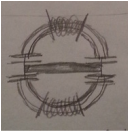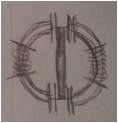It makes sense to use the Outer Ring also for maneuvering. Oriented commonly in the ways depicted here, which is shown in the first picture on the left, the di-electric medium would cause rotation of the ship "thrusting" either upward or downward, tilting the ship.
Oriented in the way depicted in the right image would cause translation movement laterally say left and right.
These images are slightly off-scale .. but it's enough to get the general idea, without giving away too much information, and also without limiting what creative designs can come after.
But since the Outer Ring is oriented as depicted in the image below, our only real option for the Townsend Brown di-electric is in a rotational value. A di-electric segment can be charged in one polarity or another to rotate the ship for example lifting up on the right side and down on the left side, and for allowing movement straight up and straight down. Once in the atmosphere, the hull plating can be electrically charged to provide movement.
Yet, since the hull plating is also using Townsend Brown style, then each hull plate section can be energized even in the vacuum of space to provide translation motion laterally (energizing those lateral plate sections on the edges), or rotational movement.
Considering that Townsend Brown's saucers were only about 3 feet in diameter and moved very fast (around 20,000 OR 200,000 miles per hour, I've heard both), it is an efficient system. Also the saucers were air-tight and completely cased / enclosed, which really says a lot.
The T. Brown di-electric did not depend upon there to be atmosphere, or air, in order to work. In fact, NASA is using di-electric orbital maneuvering and station-keeping on their satellites. I once intercepted one of their electrostatic scanning beams over my Tesla tower. It started out around 600 volts measuring on the console, but then went up to 1400 volts (if memory serves; I have that recorded on the home page somewhere). I googled "1400 volt electrostatic scanning beam" and it came back with one search item, the white paper with a part number, which was the satellite component.
The satellite made a conductive electrostatic corridor between it and my tower. When I grounded my tower, an "X" pattern would form in the sky overhead, like clouds formed instantly, telling me there was electrical interference waves due to a conductive energy corridor. That put a stop to a lot of my magneto-electrostatic experiments, because I realized that I could have sent magneto-electrostatic pulses up the beam path which might have zapped the satellite, or pushed it out of orbit. No telling what the consequences would have been if I would have done that, especially after I realized there was a satellite overhead because I detected it.
The scanning beam is di-electric, and even though it might have been ionic, I highly doubt it. I think it was an internalized propulsion system, which is funny because even though NASA manufactures it, they are still claiming the physics of the EM thruster is "unknown."
That is also discussed on the Tesla Engineering Physics page. There's an article about "Stressing the di-electric" involved with Townsend Brown's research on the Updates and Design Improvement page.
Keep in mind, the Outer Ring is actually very large ...
So now, everything is covered. Power generation, gravity cancellation, radiation shielding, fast warp travel, and maneuvering.
Exotic unification of the "Light-drive" aspect is mainly geometry at this point. However with all these systems, and some are redundant systems, then there may actually be some room for a little experimentation in that area.
Private verification of some of these systems do come with the signing of non-disclosure agreements, for proprietary reasons, currently.
There are design variations possible using these common, core principles; there are no absolutes.
I feel it has all been thoroughly examined, and the information on this site fully realized and standing solid.
The more we learn and realize, the more these systems are further validated and verified.
The vertical core has been updated, but the original Hamel-style design remains valid in its principle, particularly thanks to the EM drive.
If you take into consideration that the new upgraded vertical core impeller uses Townsend Brown electrodynamics, along with a charged particle flow, then it should be one fast engine.
NOTES:
A T. Brown di-electric core is logical, particularly in this geometry. The Outer Ring is a non-moving component, so the di-electric core can be switched on and off. It seems that it's orientation will be in one-way-only, however. So the hull plating will have to be used for maneuvering primarily.
Like in the image below ... for rotation. Lateral movement is possible on the wing-tip edges, using the same concept ... The drawing doesn't really reflect it too well, and it could be a little more for small maneuvering, but you should get the idea .........
~.~.~.~.~.~.~.~.~





 RSS Feed
RSS Feed